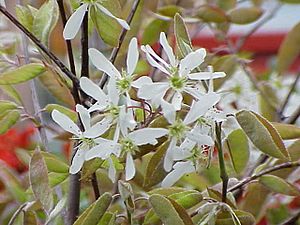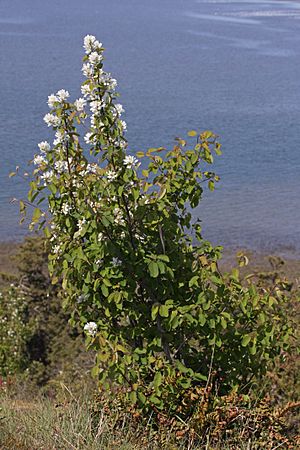Amelanchier facts for kids
Quick facts for kids Amelanchier |
|
|---|---|
 |
|
| Scientific classification |
|
| Kingdom: | Plantae |
| Clade: | Tracheophytes |
| Clade: | Angiosperms |
| Clade: | Eudicots |
| Clade: | Rosids |
| Order: | Rosales |
| Family: | Rosaceae |
| Subfamily: | Amygdaloideae |
| Tribe: | Maleae |
| Subtribe: | Malinae |
| Genus: | Amelanchier Medik. |
| Species | |
|
About 20; see text |
|
Amelanchier (am-ə-LAN-sheer) is a group of plants also known by many fun names! You might hear them called shadbush, serviceberry, juneberry, or saskatoon. These plants are usually shrubs or small trees. They belong to the rose family (called Rosaceae), just like apples and strawberries.
There are about 20 different kinds, or species, of Amelanchier. Their leaves fall off in autumn, which is why they are called deciduous plants.
These plants grow naturally in cooler parts of the Northern Hemisphere, especially in North America. You can find them in almost every U.S. state and Canadian province. A few species also grow in Asia and Europe. It can be tricky for scientists to tell the different Amelanchier species apart. This is because they can easily hybridize (mix genes) and sometimes make seeds without needing pollen from another plant.
Amelanchier plants can be tiny, only 0.2 meters (less than a foot) tall, or grow into small trees up to 20 meters (about 65 feet) tall. Some grow as single trees, while others form bushy clumps. Their bark is usually gray. The leaves are simple and come in different shapes.
Their flowers are usually white and have five petals. They bloom in early spring. In North America, people sometimes call them "shadbush" because they flower when a fish called "shad" swims upstream to lay its eggs. The fruit is like a small berry, turning red, purple, or almost black when ripe. It's usually sweet and ready to eat in summer.
People like Amelanchier plants for their beauty in gardens. Their fruits are also an important food source for many wild animals.
Contents
Different Kinds of Amelanchier
Scientists have studied Amelanchier plants all over the world. Here are some of the well-known species:
- Amelanchier alnifolia – Saskatoon serviceberry
- Amelanchier arborea – Downy serviceberry
- Amelanchier asiatica – Korean juneberry
- Amelanchier canadensis – Eastern shadbush
- Amelanchier laevis – Smooth serviceberry
- Amelanchier lamarckii – Juneberry (often grown in gardens)
- Amelanchier ovalis – Snowy mespilus
- Amelanchier sinica – Chinese serviceberry
- Amelanchier spicata – Low juneberry
- Amelanchier utahensis – Utah serviceberry
Garden Varieties
Because Amelanchier plants can easily mix and create new types, many plants sold in nurseries are actually hybrids. These are plants that are a mix of two different species. For example, A. × grandiflora is a garden hybrid.
One very popular type grown in Europe is Amelanchier lamarckii. It was brought to Europe a long time ago. Even though it comes from North America, it doesn't grow wild there anymore.
What Their Names Mean
The name Amelanchier likely comes from an old French word, amalenquièr, which was used for the European Amelanchier ovalis.
The name serviceberry might come from how its fruit looks similar to another plant called Sorbus.
Juneberry is easy to guess! It's because the fruits of some species become ripe in June.
The name saskatoon comes from the Cree language, an Indigenous language in Canada. The word misâskwatômina means Amelanchier alnifolia. The city of Saskatoon, Saskatchewan, is even named after this plant!
Shadberry refers to the "shad runs." This is when shad fish swim up rivers in New England. The Amelanchier trees often bloom around the same time the fish appear.
Who Eats Amelanchier?
Amelanchier plants are a favorite food for animals like deer and rabbits. Many different kinds of caterpillars and other insects also like to munch on their leaves.
However, these plants can also get sick. Some insects and diseases that affect fruit trees can also harm Amelanchier. For example, a disease called fireblight can spread to them.
How People Use Amelanchier
The fruits of many Amelanchier species are delicious to eat raw. They taste a bit like a blueberry, but with a hint of almond flavor from the seeds. Some types, especially the saskatoon berry, are grown on farms just for their fruit.
People use the fruits to make pies and jams. Native Americans used saskatoon berries in a traditional food called pemmican. This was a mix of dried meat, fat, and berries.
The wood of Amelanchier is strong and heavy. It has been used to make tool handles and fishing rods. Native Americans also used it for arrow shafts. Some even used the wood to make a type of body armor!
Amelanchier in Gardens
Many Amelanchier species are popular ornamental shrubs for gardens. People love them for their pretty flowers, interesting bark, and beautiful fall colors. To grow well, they need good drainage and air circulation. They also need water when it's dry.
Even George Washington planted Amelanchier trees at his home, Mount Vernon, in Virginia.
Images for kids
See also
 In Spanish: Amelanchier para niños
In Spanish: Amelanchier para niños



